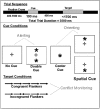The influence of concentrative meditation training on the development of attention networks during early adolescence
- PMID: 21808627
- PMCID: PMC3137946
- DOI: 10.3389/fpsyg.2011.00153
The influence of concentrative meditation training on the development of attention networks during early adolescence
Abstract
We investigate if concentrative meditation training (CMT) offered during adolescent development benefits subsystems of attention using a quasi-experimental design. Attentional alerting, orienting, and conflict monitoring were examined using the Attention Network Test (ANT) in 13-15 year old children who received CMT as part of their school curriculum (CMT group: N = 79) vs. those who received no such training (control group: N = 76). Alerting and conflict monitoring, but not orienting, differed between the CMT and control group. Only conflict monitoring demonstrated age-related improvements, with smaller conflict effect scores in older vs. younger participants. The influence of CMT on this system was similar to the influence of developmental maturity, with smaller conflict effects in the CMT vs. control group. To examine if CMT might also bolster conflict-triggered upregulation of attentional control, conflict effects were evaluated as a function of previous trial conflict demands (high conflict vs. low conflict). Smaller current-trial conflict effects were observed when previous conflict was high vs. low, suggesting that similar to adults, when previous conflict was high (vs. low) children in this age-range proactively upregulated control so that subsequent trial performance was benefitted. The magnitude of conflict-triggered control upregulation was not bolstered by CMT but CMT did have an effect for current incongruent trials preceded by congruent trials. Thus, CMT's influence on attention may be tractable and specific; it may bolster attentional alerting, conflict monitoring and reactive control, but does not appear to improve orienting.
Keywords: attention; conflict adaptation; conflict monitoring; development; meditation.
Figures





References
-
- Alexander C. N., Swanson G. C., Rainforth M. V., Carlisle T. W., Todd C. C., Oates R. M. (1993). Effects of the transcendental meditation program on stress-reduction, health, and employee development: a prospective study in two occupational settings. Anxiety Stress Coping 6, 245–26210.1080/10615809308248383 - DOI
-
- Anderson N. D., Lau M. A., Segal Z. V., Bishop S. R. (2007). Mindfulness-based stress reduction and attentional control. Clin. Psychol. Psychother. 14, 449–46310.1002/cpp.544 - DOI
LinkOut - more resources
Full Text Sources

